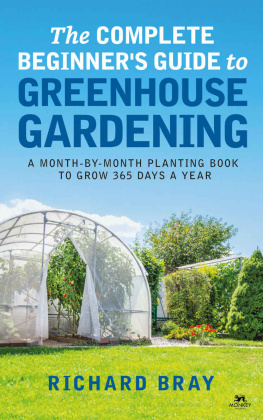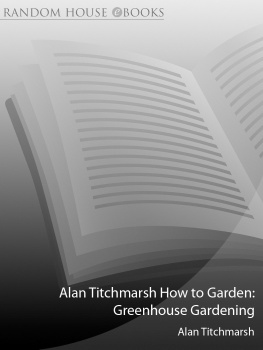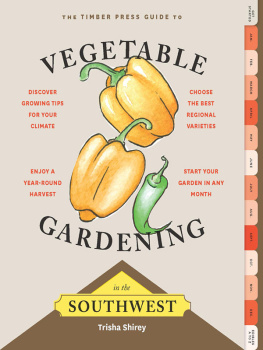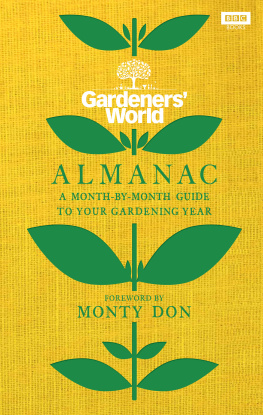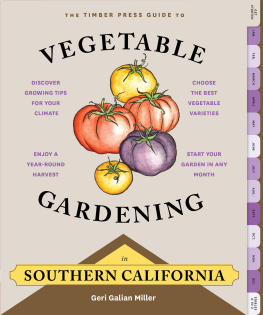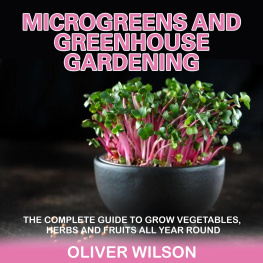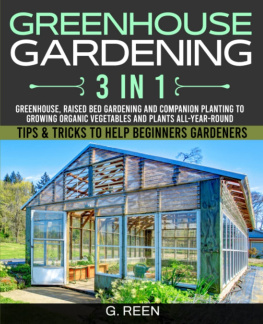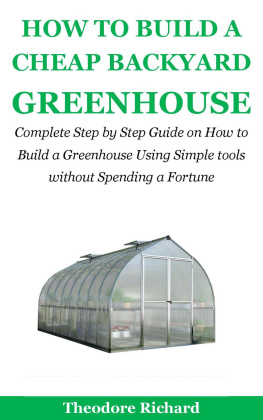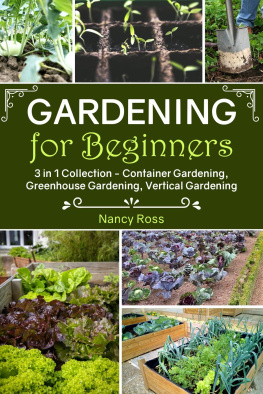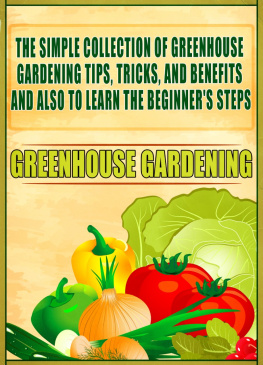Richard Bray - The Complete Beginners Guide to Greenhouse Gardening: A Month-By-Month Planting Book to Grow 365 Days a Year
Here you can read online Richard Bray - The Complete Beginners Guide to Greenhouse Gardening: A Month-By-Month Planting Book to Grow 365 Days a Year full text of the book (entire story) in english for free. Download pdf and epub, get meaning, cover and reviews about this ebook. year: 2022, publisher: Monkey Publishing, genre: Children. Description of the work, (preface) as well as reviews are available. Best literature library LitArk.com created for fans of good reading and offers a wide selection of genres:
Romance novel
Science fiction
Adventure
Detective
Science
History
Home and family
Prose
Art
Politics
Computer
Non-fiction
Religion
Business
Children
Humor
Choose a favorite category and find really read worthwhile books. Enjoy immersion in the world of imagination, feel the emotions of the characters or learn something new for yourself, make an fascinating discovery.
- Book:The Complete Beginners Guide to Greenhouse Gardening: A Month-By-Month Planting Book to Grow 365 Days a Year
- Author:
- Publisher:Monkey Publishing
- Genre:
- Year:2022
- Rating:3 / 5
- Favourites:Add to favourites
- Your mark:
- 60
- 1
- 2
- 3
- 4
- 5
The Complete Beginners Guide to Greenhouse Gardening: A Month-By-Month Planting Book to Grow 365 Days a Year: summary, description and annotation
We offer to read an annotation, description, summary or preface (depends on what the author of the book "The Complete Beginners Guide to Greenhouse Gardening: A Month-By-Month Planting Book to Grow 365 Days a Year" wrote himself). If you haven't found the necessary information about the book — write in the comments, we will try to find it.
Richard Bray: author's other books
Who wrote The Complete Beginners Guide to Greenhouse Gardening: A Month-By-Month Planting Book to Grow 365 Days a Year? Find out the surname, the name of the author of the book and a list of all author's works by series.
The Complete Beginners Guide to Greenhouse Gardening: A Month-By-Month Planting Book to Grow 365 Days a Year — read online for free the complete book (whole text) full work
Below is the text of the book, divided by pages. System saving the place of the last page read, allows you to conveniently read the book "The Complete Beginners Guide to Greenhouse Gardening: A Month-By-Month Planting Book to Grow 365 Days a Year" online for free, without having to search again every time where you left off. Put a bookmark, and you can go to the page where you finished reading at any time.
Font size:
Interval:
Bookmark:

Contents

INTRODUCTION
Greenhouse gardening is a rewarding way to grow your own vegetables, herbs and fruits and one that I hope you will enjoy as much as I do. The best thing about a greenhouse is that you don't need a patch of land in order to grow amazing crops. It can be as small and simple as you like or as complex as you can imagine.
By definition, a greenhouse is a structure within which you grow plants. It consists of a frame covered by a transparent glazing, such as glass or plastic sheeting. Greenhouses use the sun to create a warm, beneficial, growing environment. They also protect plants from the elements, pests, diseases, and allow for longer growing seasons. There are many types of greenhouse structures. They are categorized by the amount of additional heat they provide and then further categorized by the actual type of structure.
Greenhouse-like structures go back to the days of the Romans. During cold weather, Roman gardeners stored vegetable plants under frames covered in an oiled cloth. They also planted vegetables in carts that could be moved outside during the day and inside at night to protect them. There are texts from 15th century Korea describing greenhouses designed to manage temperature and humidity for optimal plant growth. Greenhouses became known in parts of Europe in the 17th century. These early greenhouses took a lot of effort to manage. Balancing the heat was a huge problem and closing them up at night or winterizing them was complicated. Charles Lucien Bonaparte, a French botanist in the early 1800s, is said to have created the first modern greenhouse. These greenhouses were called orangeries since they were mainly used to protect orange trees from harsh, freezing temperatures. Greenhouse design continued to develop during the 17th century in Europe, but the Victorian Era is when they really began to take off. They were often elaborate structures built for the wealthy to showcase their gardens.
Since then, greenhouses have become a common sight in home gardens. Their size, design, shape, and function have changed and adapted through the years, and still today, there are new innovations for better, more efficient and effective greenhouses. Most recently, the availability of polyethylene film, or heavy plastic sheeting, has radically changed how greenhouses are built. Previously, they were almost exclusively built using glass, which works well but has limitations, such as its fragility. The introduction of PVC pipe and lightweight aluminum frames has also significantly changed greenhouse building.
The main purpose of most greenhouses, especially if they are cold-frames, is to get an early start on the growing season. This means that it gets used as an interim stage before seedlings are actually placed in the garden. Many vegetables can be started in your house or other inside location under grow lights and when theyre big enough, they can be moved out to the greenhouse. Once the outside temperature is warm enough, they can then be planted in the garden. Peppers and tomatoes can be started as early as January or February inside when they have a greenhouse to relocate to after they have begun growing. This means they will be ripe a month or so before any similar plants grown without a greenhouse. Greenhouses are also used to grow plants all year round in a controlled environment. They are closed off from the elements which makes them perfect incubators for many plants. Another popular reason for using a greenhouse is to grow fruits and vegetables in the cold winter months. This usually requires a heated greenhouse, yet there is some flexibility, and a lot can depend on the temperature where it is located.

CHAPTER 1: TYPES OF GREENHOUSES
A professional greenhouse builder or gardener might take issue with what is being called a greenhouse. The term greenhouse, to most people, means a structure that holds plants and protects them from the elements while encouraging good growing conditions. A seasoned greenhouse user or a professional gardener, however, makes a very important distinction as to what constitutes a greenhouse and what doesn't.
IS IT A GREENHOUSE OR A COLD FRAME?
OVERVIEW OF DIFFERENT TYPES OF GREENHOUSES
Simply put, a greenhouse is a structure that has the means to provide internal heat. Any structure that does not have that ability is a cold frame. Cold frames provide protection, yet do not have any heating systems, relying almost exclusively on that which comes naturally from the sun.
An easy way to think of it is that a real greenhouse has a heating system installed that can run year-round if needed. It heats the entire greenhouse and keeps a consistent temperature. A cold frame doesn't have such a system installed. This doesn't mean a cold frame is without heating options. Frost covers, heat mats, cloches, portable heaters, and bubble wrap are all tools available for the cold frame greenhouse. These devices provide a small amount of heat, usually in a very concentrated manner and do not heat the entire greenhouse.
In the eyes of professional gardeners, a greenhouse allows the gardener to control the temperature and environment in ways that aren't possible with a cold frame. In this definition of greenhouses, there are three types: hothouse, warm house, and cool house. The difference between these three types lies in where it is located and the temperature maintained inside it. A hothouse has a minimum temperature of 60F (16C). A warm house has a minimum temperature of 55F (13C), and a cool house has a minimum temperature of 45F (7C). The key to these designations, and what sets them apart from cold frames is that the temperature is controlled and maintained throughout the entire greenhouse.
A greenhouse that grows plants year-round in a cold climate will need to have supplemental heating. The type of greenhouse heating that you need will depend on your climate and what you are growing. In places with a mild climate, you may only need to provide a little heating, or even none at all. Growing tomatoes, cucumbers, flowers and tropical plants will require a hothouse in places where the temperature gets quite low. A location with warm seasonal weather year-round can grow these same vegetables and flowers in a cold frame, using only the sun as heat. A greenhouse structure can be a cold-frame in the summer when the sun is sufficient for heating. Then, in winter, it can be turned into a hothouse or warm house to grow plants regardless of the temperature outside.
Many cold frame structures cannot be turned into real greenhouses, even if heat is added. Lack of proper ventilation for a heated space is a huge consideration. If the structure is small, any added heat can cook the delicate plants. Cold frame structures with single-pane glass, plastic sheeting, or polycarbonate windows do not provide any insulation. Any heat that is added will quickly dissipate, negating its addition in the first place.
This gets confusing though, because the term cold frame is also used to describe a certain type of structure. According to professional gardeners, a hoop house is a type of cold frame, as is a low tunnel and often a dome as well. An attached greenhouse, A-frame, or traditional style can be a cold frame or have heating to make it a greenhouse.
To the average gardener, this is confusing, and so in this guide, we will try to keep it simple. We will continue defining a greenhouse as any structure that holds plants. Just be aware that not everyone identifies it like this.
Font size:
Interval:
Bookmark:
Similar books «The Complete Beginners Guide to Greenhouse Gardening: A Month-By-Month Planting Book to Grow 365 Days a Year»
Look at similar books to The Complete Beginners Guide to Greenhouse Gardening: A Month-By-Month Planting Book to Grow 365 Days a Year. We have selected literature similar in name and meaning in the hope of providing readers with more options to find new, interesting, not yet read works.
Discussion, reviews of the book The Complete Beginners Guide to Greenhouse Gardening: A Month-By-Month Planting Book to Grow 365 Days a Year and just readers' own opinions. Leave your comments, write what you think about the work, its meaning or the main characters. Specify what exactly you liked and what you didn't like, and why you think so.

